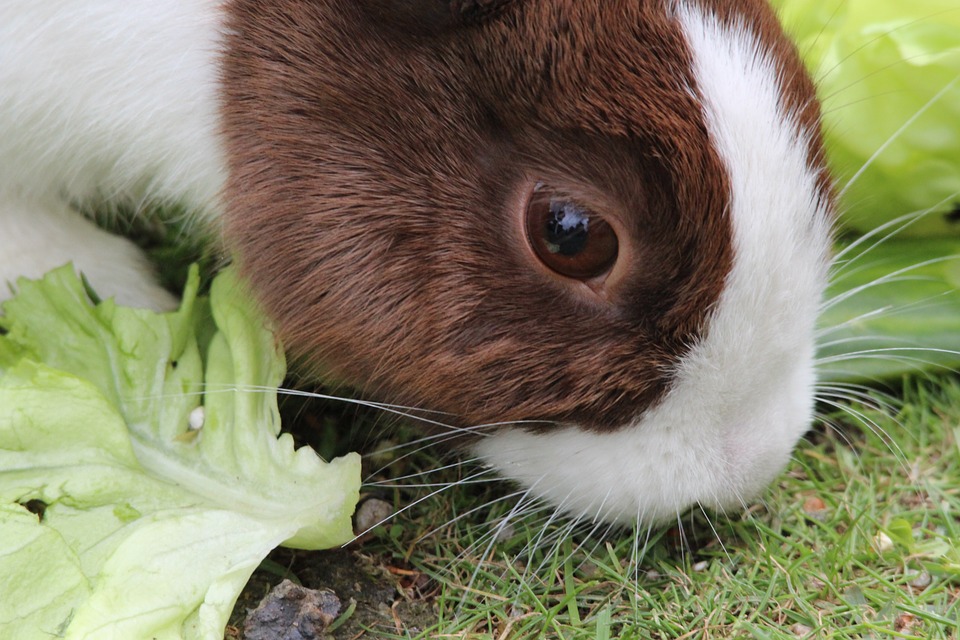This article will equip you with the knowledge and strategies needed to keep rabbits out of your garden while promoting their well-being. We'll explore various approaches, from physical barriers and natural deterrents to understanding rabbit behaviour and creating a harmonious coexistence.
Part 1: Understanding the Bunny Behaviour

1.1. What Attracts Rabbits to Gardens?
- A Feast of Delights: Rabbits adore the fresh, nutritious plants found in gardens. Their favourite treats include leafy greens like lettuce, spinach, and kale, as well as vegetables like carrots, beans, and peas. Even flowers like petunias, pansies, and geraniums are often on their menu.
- Seeking Shelter and Safety: Gardens provide ideal hiding spots and protection from predators and weather conditions. Dense foliage, raised beds, and even garden sheds can offer appealing shelter.
- The Allure of Water: Rabbits require a constant supply of fresh water. Gardens often have a variety of sources, from ponds and birdbaths to leaky taps and even puddles after rain.
1.2. Rabbit Feeding Habits
- Grazing Masters: Rabbits are natural grazers, spending significant time throughout the day nibbling on a diverse range of plants.
- Seasonal Foodies: Their dietary preferences change with the seasons. In spring, they favour tender shoots and young growth, while in autumn, they focus on fruits and seeds.
- Dawn and Dusk Activity: Rabbits are primarily active at dawn and dusk, often coinciding with prime gardening hours. This is when they are most likely to venture into gardens.
Part 2: Creating Impassable Barriers

2.1. Fencing: A Secure Perimeter
2.1.1. Choosing the Right Fence
- Reach for the Sky: Rabbits are excellent jumpers, so fences should be at least 4 feet tall, ideally 5 feet. This ensures even the most agile bunny can't hop over.
- Solidity is Key: Choose solid fencing materials like chicken wire, metal mesh, or hard plastic. Loosely woven materials are easily breached by determined rabbits.
- Bury the Evidence: To prevent digging, bury the bottom of the fence 6-12 inches below ground level. This creates a secure barrier that prevents rabbits from burrowing underneath.
- Angle for Success: A slight inward angle at the top of the fence can discourage rabbits from attempting to jump over it.
2.1.2. Fence Installation: A Strong Foundation
- Strong and Secure Posts: Use robust posts made from wood, metal, or concrete and secure them firmly in the ground with concrete.
- Overlap for No Gaps: Overlap fencing panels to eliminate gaps that rabbits can squeeze through. Ensure the panels are securely fastened together.
- Regular Inspections: Inspect the fence regularly for damage or gaps. Repair any weaknesses promptly to prevent rabbits from finding a way in.
2.2. Netting: A Flexible and Versatile Solution
2.2.1. Types of Netting: The Right Choice for Your Needs
- Bird Netting: This lightweight netting is ideal for covering raised beds or individual plants, deterring smaller rabbits.
- Plastic Netting: More durable and resistant to wear and tear, plastic netting is suitable for larger areas or protecting vulnerable plants.
- Mesh Panels: These panels offer a flexible solution for creating temporary enclosures around precious plants. They can be easily moved and adjusted as needed.
2.2.2. Netting Installation: A Secure Fit
- Secure Attachment: Use sturdy clips or ties to attach netting to fences, stakes, or trellises. Ensure it's securely fastened to prevent sagging or loosening.
- Taut and Tight: Make sure the netting is taut and secure, with no loose areas that rabbits could exploit.
- Aesthetic Considerations: Choose netting that blends in with the surroundings. There are options available in various colours and materials to minimize visual impact.
Part 3: Harnessing Nature's Power: Natural Deterrents
3.1. Planting Power: Utilizing Plant Defences
3.1.1. Strong Scents: A No-Go for Rabbits
- Lavender: Rabbits are repelled by the strong scent of lavender. Plant lavender bushes along garden borders or intersperse them with vulnerable plants.
- Rosemary: Its pungent aroma is disliked by rabbits. Plant rosemary around vegetable patches or use sprigs of rosemary to create a fragrant barrier.
- Garlic: The pungent odour of garlic can also deter rabbits. Plant garlic cloves around the perimeter of your garden or mix garlic water with a spray bottle and apply it around vulnerable plants.
- Chives: The sharp smell of chives is often unappealing to rabbits. Plant chives along borders or in pots to create a fragrant deterrent.
3.1.2. Spiky Plants: A Natural Barrier
- Roses: Thorny rose bushes deter rabbits from nibbling on their stems and leaves. Plant roses along borders or around vulnerable plants.
- Holly: Prickly holly leaves make it an effective barrier against rabbits. Plant holly bushes or use holly branches to create a thorny hedge.
- Barberry: This shrub’s sharp spines are not appealing to rabbits. Barberry bushes can be used as a natural barrier along borders or around gardens.
3.2. Scents and Sounds: A Multi-Sensory Approach
3.2.1. Commercial Repellents: Utilising Scent
- Predator Urine: These commercially available sprays and granules mimic the scent of predators, deterring rabbits. They should be applied regularly, especially around vulnerable areas.
- Peppermint Oil: The strong scent of peppermint oil can be a deterrent for rabbits. Dilute peppermint oil in water and spray it around the garden or use peppermint oil diffusers in your garden.
- Garlic Spray: A homemade garlic spray can be made by blending garlic with water and straining the mixture. Spray this solution around plants to deter rabbits.
3.2.2. Sounds: Disrupting the Peace
- Motion-Activated Sprinklers: These sprinklers use sensors to detect movement. When a rabbit approaches, they trigger a sudden burst of water, startling the rabbit and deterring it from returning.
- Ultrasonic Emitters: These devices emit high-frequency sounds that are irritating to rabbits but inaudible to humans. Place them strategically around the garden.
Part 4: Garden Design: A Rabbit-Resistant Landscape
4.1. Planting Choices: A Strategic Selection
4.1.1. Rabbit-Resistant Plants: A Safe Haven
- Herbs: Many herbs like thyme, sage, oregano, and mint are generally not favoured by rabbits. They add flavour to your garden and deter unwanted guests.
- Flowers: Rabbits often avoid certain flowers like marigolds, daffodils, and zinnias. They add colour to your garden and are a safe bet against bunny nibbling.
- Vines: Climbing vines like clematis and honeysuckle can be less appealing to rabbits, adding vertical interest to your garden while deterring rabbits.
4.1.2. Avoiding Attractive Plants: Minimising Temptation
- Leafy Greens: Rabbits adore lettuces, spinach, and kale. Consider growing these in containers or raised beds, or planting them in areas that are well-protected from rabbits.
- Vegetables: Carrots, beans, and peas are prime targets for rabbits. Use netting, fencing, or raised beds to protect these vulnerable plants.
- Flowers: Petunias, pansies, and geraniums are often nibbled on by rabbits. If you plant these flowers, consider using deterrents or growing them in containers.
4.2. Garden Layout: Minimising Hiding Spots
4.2.1. Open Spaces: Creating an Unwelcoming Environment
- Avoid Hiding Spots: Minimise areas where rabbits can hide or nestle. Keep your garden tidy and trim any overgrown areas that could provide shelter.
- Maintain Visibility: Keep pathways clear and avoid overgrown areas that create hidden spaces where rabbits can hide.
4.2.2. Plant Placement: Strategically Positioned Plants
- Grouped Plants: Planting vulnerable plants in clusters can make them less enticing to rabbits. This creates a visual deterrent.
- Perimeter Barriers: Create a perimeter of rabbit-resistant plants around your garden to deter entry. This creates a natural barrier that rabbits are less likely to cross.
Part 5: Harmonious Coexistence: Living in Balance
5.1. Understanding Rabbit Needs: A Respectful Approach
- Alternative Food Sources: Provide alternative food sources for rabbits outside your garden, such as wildflower patches, clover patches, or dedicated feeding areas.
- Wildlife-Friendly Habitat: Create a wildlife-friendly habitat with shrubs, brush piles, or nesting boxes. This provides a safe and secure place for rabbits to live and raise their young.
- Water Access: Ensure a reliable water source is available for rabbits. A shallow birdbath, a container filled with fresh water, or even a leaky tap can provide them with a drink.
5.2. Minimising Conflict: Building a Peaceful Relationship
- Respect Boundaries: Be mindful of rabbit territories and avoid encroaching on them. Give them space to roam freely.
- Reduce Attractants: Keep garbage bins secure and remove any spilled food or water sources. This reduces the allure of your garden for rabbits.
- Educate Others: Inform neighbours and community members about the importance of humane rabbit deterrents. This encourages a shared commitment to responsible rabbit management.
Part 6: FAQs: Answers to Common Questions
6.1. What are the most effective rabbit deterrents?
A combination of methods is often the most effective. Physical barriers like fencing and netting are crucial. Natural deterrents like strong-scented plants, predator urine, and motion-activated sprinklers can further deter rabbits.
6.2. How do I deal with a rabbit that has already entered my garden?
Gently guide the rabbit out. Use a broom or a long stick to push it towards an open area. Avoid using force or harming the rabbit.
6.3. Are commercial rabbit repellents effective?
Their effectiveness can vary depending on the product and the individual rabbit. Read product labels carefully and use repellents according to their instructions.
6.4. Can I use human hair or dog hair to deter rabbits?
There's no scientific evidence to support this claim. Rabbits have a strong sense of smell, but they're unlikely to be deterred by the smell of hair alone.
6.5. What are some humane ways to catch a rabbit?
Use a live trap baited with food. Relocate the rabbit to a safe area away from your garden. Check with your local authorities before relocating any wild animal.
6.6. Is it legal to relocate a rabbit?
Relocating a rabbit may be illegal in some areas, depending on local wildlife regulations. Check with your local authorities.
6.7. Are rabbits harmful to gardens?
While rabbits can cause damage by nibbling on plants, they are an important part of the ecosystem. They control plant growth and provide food for predators.
Everyone is watching
-

Do Rabbits Lay Eggs? (The Surprising Truth)
OTHER TYPES OF PETSThis article will unravel the common misconception that rabbits lay eggs, exploring the fascinating world of r...
-

What's a Group of Rabbits Called? (A Comprehensive Guide)
OTHER TYPES OF PETSThis article delves into the fascinating world of rabbits, exploring the various terms used to describe a grou...
-

Can Rabbits Eat Grapes? A Guide to Safe Rabbit Treats
OTHER TYPES OF PETSThis comprehensive guide will explore the safety and suitability of grapes for rabbits, providing detailed inf...
-

Predators That Hunt Rabbits: A Guide to Natural Enemies
OTHER TYPES OF PETSI've always been fascinated by the circle of life, that delicate dance between predator and prey. Growing up ...
-

Are Rabbits Nocturnal Animals?
OTHER TYPES OF PETSThe question of whether rabbits are nocturnal animals is a fascinating one, with a surprisingly complex answer...
